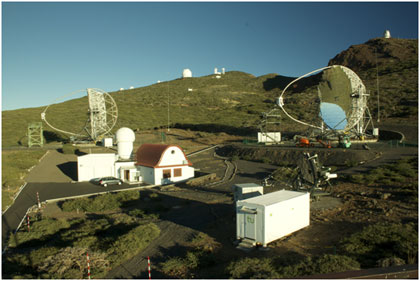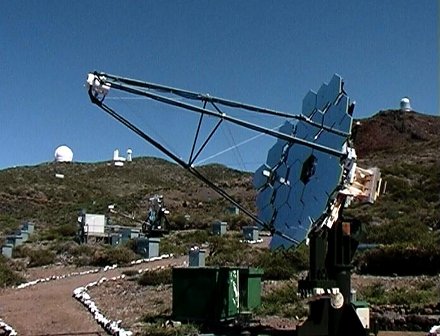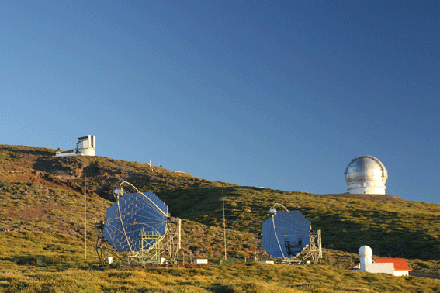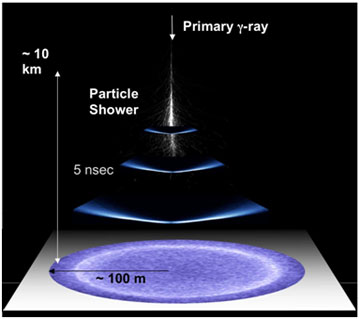MAGIC
Skip navigation and go to main content
- Home
- General Information
- Science with MAGIC
- MAGIC members
- Maintenance

Introduction
MAGIC is a system of two imaging atmospheric Cherenkov telescopes (or IACTs). MAGIC-I started routine operation after commissioning in 2004. Construction of MAGIC-II was completed in early 2009, and the two telescopes have been in operation ever since, with a break in 2012 for an upgrade that achieved full homogeneity. The project is funded primarily by the funding agencies BMFB (Germany), MPG (Germany), INFN (Italy), MICINN(Spain), and the ETH Zurich (Switzerland).

The two MAGIC Telescopes and the Control Building at the Observatory of the Roque de Los Muchachos, La Palma, Canary Islands (Spain). In front the FACT experiment
The picture above shows the two MAGIC Telescopes which are, with their 236 m2 reflective surface each, among the largest operating IACTs. In front the  FACT experiment a new small IACT using one of the former HEGRA telescopes. The
FACT experiment a new small IACT using one of the former HEGRA telescopes. The  precursor experiment HEGRA used several telescopes of the same type, but of smaller size; the one renewed for the FACT experiment is shown in the photograph below.
precursor experiment HEGRA used several telescopes of the same type, but of smaller size; the one renewed for the FACT experiment is shown in the photograph below.

Former HEGRA Telescope now FACT experiment since 2011
The Roque de los Muchachos site is situated on the Canary island of La Palma, a volcanic island off the African coast at 28oN and 17oW. The site has excellent conditions for optical observations, and is run by the  IAC. It is also under consideration for an ultra-large optical telescope.
IAC. It is also under consideration for an ultra-large optical telescope.
The MAGIC site is at an altitude around 2200 above sea level.

Another view of the Magic Telescopes in 2009 with the TNG (left) and GTC (right) in the foreground
Up to the rim at 2500m, multiple high-quality optical telescopes are installed, as seen in the photograph above. It shows in the foreground the MAGIC telescopes and the MAGIC control building, featuring a red roof and a dome for a LIDAR. Above MAGIC, two optical telescopes are visible, the Telescopio Nazionale Galileo (left), and the Gran Telescopio Canarias (GTC), with its 10.4m diameter segmented mirror the largest worldwide, and in operation since 2011.
Imaging atmospheric Cherenkov telescopes
The cosmos and its evolution are studied using all radiation, charged cosmic rays, neutrinos, and, in particular, electromagnetic waves. The electromagnetic spectrum extends from radio waves (at wavelengths of several tens of meters, or energies of 10-9 eV) to ultra-high enery gamma quanta (wavelengths of picometers or energies of 100 TeV). Observations at visible wavelengths (.5 to 1 micrometer) have a history of centuries, gamma astronomy by satellites (keV to few GeV) and ground-based telescopes (above 300 GeV) are end-of-20th century newcomers. IACTs are ground-based telescopes for the detection of very high energy (VHE) electromagnetic particles, in particular gamma rays. Having no electric charge, VHE gammas are not affected by magnetic fields, and can, therefore, act as messengers of distant cosmic events, allowing straight extrapolation to the source. Although high-energy gamma quanta get absorbed in the atmosphere, they can be observed indirectly. The absorption process proceeds by creation of a cascade or shower of high-energy secondary particles. The Cherenkov method uses the fact that the charged secondary particles emit radiation at a characteristic angle, the Cherenkov radiation. Cherenkov photons have energies in the visible and UV range, and pass through the atmosphere; thus they can be observed on the surface of the earth by sufficiently sensitive instruments. You will find more about IACTs in a dedicated page.

Credits: Cherenkov Telescope Array in Argentina
The physics case for IACTs
Most generally, the observation of gamma rays (electromagnetic radiation of high energy) is one aspect of astroparticle physics. Astroparticle physics is a new field developing as an intersection of Particle Physics, Nuclear Physics, Astrophysics, Gravitation and Cosmology. One of its cornerstones is Cosmic Ray Physics, which has its origins many decades in the past; then scientists observed in balloons and in mountain top laboratories the many charged particles impinging upon the earth. Today, the field has substantially widened, and includes all particles. Particularly in recent years, activities (and funding) have accelerated, with fundamental discoveries being made at an astonishing frequency. Using the understanding of particle interactions at very high energies, as derived from experiments in accelerator laboratories, the picture of how the universe developed since its earliest beginnings, some ten billion years ago, is changing fast. Theoretical models fuel multiple experiments, using different particles coming to earth from space.
Very high energy gamma astronomy using ground-based telescopes is a recent addition to the panoply of astroparticle physics instruments and the number of established sources is continuously increasing.